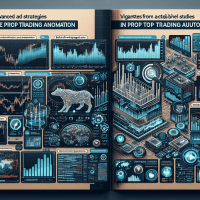Prop Trading Automation: Gaining a Strategic Edge
In the fast-paced world of prop trading, automation is no longer a luxury but a necessity. As trading strategies become increasingly complex, the need for reliable, accurate, and fast automation systems has become paramount. This guide delves into the intricacies of prop trading automation, offering detailed insights into advanced backtesting techniques, comparative tool analyses, and actionable strategies tailored for both emerging traders and seasoned professionals.
Why Prop Trading Automation Matters
Automation in prop trading not only improves execution speed but also minimizes human error during strategy implementation. With regulatory frameworks such as MiFID II and NFA rules influencing market operations, automated systems ensure compliance while optimizing risk management metrics such as Sharpe Ratio, drawdown limits, and profit factors.
Enhancing Strategy Accuracy and Risk Mitigation
Automated backtesting tools provide a powerful approach to validate trading hypotheses. By addressing key pitfalls such as overfitting, survivorship bias, and look-ahead bias, these tools help traders fine-tune strategies before live deployment. For example, utilizing methods like walk-forward optimization alongside traditional backtesting can help in understanding how strategies perform under evolving market conditions.
Comparative Analysis: Leading Backtesting Tools for Prop Trading
Prop trading firms rely on robust automated backtesting systems to simulate market conditions and ensure strategies stand up under rigorous testing. Below, we detail a comparison of some of the top tools in the market:
TradingView vs. NinjaTrader vs. Interactive Brokers
| Tool | Backtesting Features | Data Quality & Availability | Integration Capabilities | Pricing & Use Cases |
|---|---|---|---|---|
| TradingView | Event-driven and vectorized tests, slippage & commission simulations, optimization algorithms. | Deep historical data across multiple assets, reliable real-time feeds. | API access with broker integrations, compatible with various analytical tools. | Free and tiered subscriptions; ideal for both retail traders and smaller prop firms. |
| NinjaTrader | Advanced simulation with built-in stress testing, integrated optimization. | Comprehensive historical database, supports tick and bar data. | Robust API, and seamless integration with third-party brokerage platforms. | Competitive pricing, scalable for institutional use and collaborative prop trading environments. |
| Interactive Brokers | Automated backtesting using Quantitative modules; supports both retrospective and forward analysis. | High-quality, multi-asset historical data, real-time feeds across global markets. | Extensive API, deep integration with proprietary analytics platforms. | Tiered pricing structure, suitable for prop firms requiring team collaboration and compliance tools. |
Each of these tools uniquely serves both retail and institutional traders. For instance, while TradingView is more accessible for beginners through its affordable, user-friendly interface, NinjaTrader and Interactive Brokers offer advanced analytical capabilities that are particularly suited to the rigorous demands of proprietary trading environments.
Advanced Backtesting Concepts and Best Practices
For traders aiming to justify investment in automation, understanding the distinction between traditional backtesting and more dynamic methods is crucial.
Overcoming Common Pitfalls
One enduring challenge in backtesting is overfitting – where a model works flawlessly on historical data but fails in live trading. The integration of out-of-sample testing is fundamental. By setting aside a portion of the data for testing, traders can verify that their models perform well beyond the in-sample period.
Walk-Forward Optimization vs. Traditional Backtesting
Walk-forward optimization is a powerful technique that continuously adapts to market changes. Unlike traditional static backtesting, walk-forward divides data into rolling training and testing sets. This approach aids in capturing evolving market dynamics and delivers robust performance metrics such as improved Sharpe ratios and lower drawdowns. Many prop trading firms have successfully deployed walk-forward models to dynamically adjust risk parameters and optimize trade execution based on current market conditions.
Integrating Backtesting with Forward Testing
While historical backtesting provides insights, integrating these results with forward testing (or paper trading) is essential. Forward testing validates the live feasibility of strategies and serves as a bridge between the simulation and implementation phases. Monitoring key performance indicators like profit factor and maximum drawdown during this phase is critical to avoid unexpected losses in live trading environments.
Practical Implementation: From Code to Real-world Trading
Let’s take a look at a sample Python snippet using Backtrader, a popular framework for automated backtesting:
import backtrader as bt
class TestStrategy(bt.Strategy):
def __init__(self):
self.sma = bt.indicators.SimpleMovingAverage(self.data.close, period=15)
def next(self):
if self.data.close[0] > self.sma[0]:
self.buy()
elif self.data.close[0] < self.sma[0]:
self.sell()
cerebro = bt.Cerebro()
cerebro.addstrategy(TestStrategy)
# Data feed, commission settings, etc. would follow here
cerebro.run()
This code demonstrates a simple moving average crossover strategy. Such examples are the stepping stone to developing more intricate models using your favorite automated systems.
Regulatory Considerations and Compliance Tools
Prop trading environments must navigate a maze of regulations, making it vital to integrate compliance checks into your automated systems. Frameworks like MiFID II and ESMA often require rigorous reporting and risk management protocols. Tools like NinjaTrader and Interactive Brokers include features that help prop firms stay compliant with automated regulatory reporting, ensuring that all trades are recorded and monitored appropriately.
Case Study: Automation in Action at a Leading Prop Firm
An established proprietary trading firm recently revamped its strategy development process by integrating backtesting with forward testing. The firm encountered challenges with overfitting in their preliminary models. By implementing walk-forward optimization and out-of-sample tests using Interactive Brokers’ advanced modules, they noted a 15% improvement in their Sharpe ratio and a significant reduction in strategy drawdown. The success was further bolstered by utilizing TradingView’s intuitive interface for preliminary strategy design and NinjaTrader for rigorous stress testing. This multi-tool approach allowed the firm to effectively balance strategy innovation with risk management and regulatory compliance.
Expert Guidance and Pro Tips
Pro Tip: Always validate backtesting results with live market data in a controlled simulation before deploying any trading strategy. Combining historical accuracy with current market conditions will help preempt potential pitfalls like look-ahead bias.
Industry Insight
Modern prop trading automation increasingly relies on scalable cloud-based solutions. These systems not only facilitate real-time processing of high-frequency data streams but also enable seamless integration between various analytics platforms and broker APIs. Staying abreast of these technological innovations is essential for survival in today’s highly competitive trading landscape.
Internal Resources and Next Steps
For further insight, be sure to review our articles on Advanced Backtesting Techniques and Risk Management Best Practices. They offer detailed frameworks and additional case studies for deepening your understanding of prop trading automation.
Downloadable Risk Management Checklist
As part of our commitment to empowering traders, we’ve developed a comprehensive Risk Management Checklist. This resource covers key steps for evaluating data quality, ensuring regulatory compliance, and correctly integrating forward testing into your live strategies. Below is an outline of what this checklist includes:
- Data Quality Assessment: Verification of tick data vs. bar data integrity.
- Compliance Checks: A summary of MiFID II, ESMA, and NFA regulatory requirements.
- Backtesting Protocol: Steps to mitigate overfitting and look-ahead bias.
- Forward Testing Guidelines: Key performance indicators and live testing protocols.
Implementing this checklist can dramatically reduce strategic risks and operational errors in prop trading frameworks.
Conclusion
Prop trading automation is reshaping the landscape for both retail and institutional traders. By leveraging advanced backtesting, robust compliance strategies, and dynamic integration techniques, firms can achieve significant performance improvements and risk mitigation. The fusion of established analytical tools such as TradingView, NinjaTrader, and Interactive Brokers provides a strong competitive edge in today’s fast-evolving markets.
As of October 2023, staying updated with these advancements is crucial for continued success. We highly recommend reviewing your current automation strategies and considering the integration of walk-forward optimization techniques. For a deeper dive into these topics, join our upcoming webinar or subscribe to our newsletter for regular updates on prop trading best practices.
Next Step: Download our detailed Risk Management Checklist and sign up for our exclusive webinar to further enhance your trading strategies and ensure long-term success in prop trading automation.







